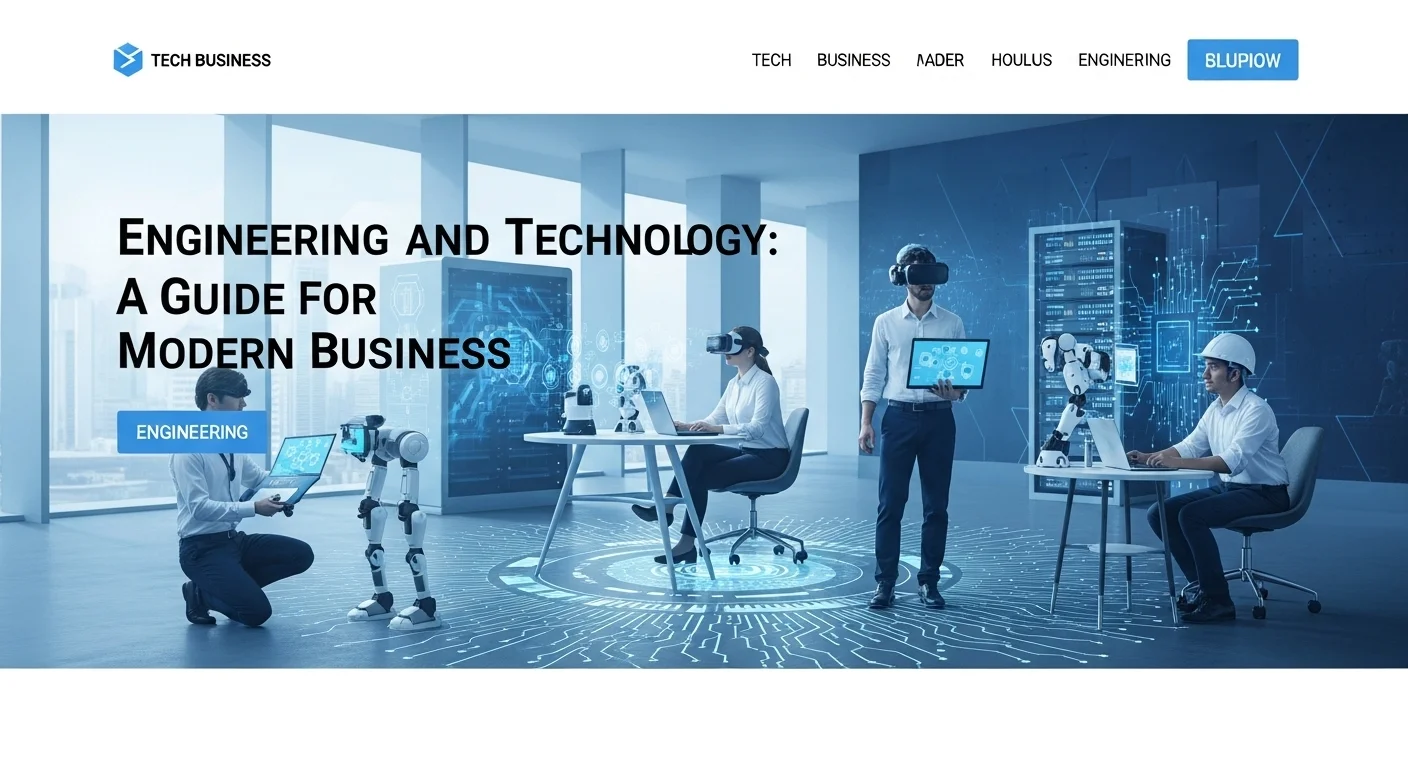How Engineering Really Powers Your Business: A Tech Insider's Guide

Executive Summary
In my years working in tech, I've noticed people often use 'engineering' and 'technology' as if they're the same thing. But the real magic, the secret sauce to business success, happens when you understand the difference. Technology gives us amazing tools, but engineering is the thoughtful craft of using those tools to build something reliable, efficient, and strong. This guide is my attempt to pull back the curtain. We'll explore how specialized fields like Site Reliability Engineering (SRE) keep your digital storefront open 24/7, building unshakable customer trust. We'll look at the rise of the Platform Engineer, the person who builds the 'super-highway' for your software developers so they can create and innovate at lightning speed. We'll also simplify complex ideas like Model-Based Systems Engineering (MBSE), which is just a smart way to manage massive tech projects without the chaos. By the end, you'll see engineering not as a cost center, but as the powerful engine driving your business forward into the future.
Table of Contents
Table of Contents
- What is Engineering, and Why Does It Matter in Tech?
- The Pillars of Modern Tech Engineering
- Designing and Building the Future
What is Engineering, and Why Does It Matter in Tech?
In today's business world, 'Engineering' and 'Technology' get thrown around a lot, often together. But let's get personal for a moment. Think of it like this: technology is a pile of high-tech bricks, circuits, and code. It’s powerful, full of potential, but it's just a pile. Engineering is the architect and the master builder who uses scientific and practical knowledge to turn that pile into a skyscraper—a structure that's not only impressive but also safe, functional, and built to last. Engineering gives technology its purpose, its reliability, and its ability to scale. It’s the discipline that transforms a brilliant, fleeting idea into a real-world solution that customers can depend on, day in and day out.
This is where a field called engineering technology comes into play, and it's where the rubber really meets the road. I've worked with brilliant engineers who could design incredible systems on paper. But it was the engineering technologists who figured out how to actually build, test, and implement those designs in the messy real world. They are the hands-on problem-solvers, the ones who make sure a design is not just a cool theory but is also practical to manufacture and maintain. In the fast-paced tech industry, where being first and being reliable can make or break a company, this practical skill is absolutely priceless. Businesses depend on these folks to turn a blueprint for a new server farm or a software update into a living, breathing part of the company's infrastructure.
The Pillars of Modern Tech Engineering
As technology has gotten more complicated, so has the engineering behind it. A few key roles have become absolutely essential for any business that relies on digital systems. Understanding what these people do is key to understanding how modern tech is built and kept alive.
One of the most important roles I've seen emerge is Site Reliability Engineering (SRE). The idea, which came out of Google, is simple but revolutionary: treat the job of running a system like a software problem. Instead of a team manually fixing servers when they break, an SRE team writes code to automate that work, making the whole system stronger and more resilient. I remember my first time on-call for a major e-commerce platform during Black Friday. The stress was immense, but our SRE principles were our guide. We were responsible for keeping the site fast and available. We had clear targets, called Service Level Objectives (SLOs), and an 'error budget'—a pre-agreed amount of downtime we were 'allowed'. If we stayed within our budget, we could roll out new features. If we went over, all new development stopped to focus on stability. This data-driven approach takes the emotion out of decisions and is a lifeline for any business that needs to be 'always on' for its customers.
Another role I'm incredibly passionate about is the platform engineer. Imagine your software developers are world-class chefs. A platform engineer builds them the perfect kitchen. As software gets more complex with microservices and cloud technology, chefs can get bogged down just trying to keep the ovens and stoves working. A platform engineer builds an 'Internal Developer Platform' (IDP) that handles all that underlying complexity. This IDP gives developers a set of pre-approved, optimized tools and workflows—we call them 'golden paths'—to build, test, and launch their creations. By giving developers this kind of self-service power, platform engineering teams help the business innovate faster and more securely. It's a game-changer for getting new ideas to market quickly and safely.
Designing and Building the Future
When you're building something incredibly complex, like an autonomous car or a global cybersecurity network, you can't just sketch it on a napkin. You need a more rigorous approach. That's where model-based systems engineering (MBSE) shines. Instead of relying on mountains of separate documents that quickly go out of date, MBSE uses a single, unified digital model as the 'single source of truth' for the entire project. This model shows how every single piece—hardware, software, requirements—connects and interacts. It’s been a lifesaver on projects I’ve been on, allowing mechanical, electrical, and software teams to see how a change in one area might impact another, catching huge problems long before we build anything physical. For a business, this means dramatically lower risk, fewer costly errors, and a faster path from concept to completion.
Finally, let's not forget the manufacturing engineer. This role might sound old-school, but it's more critical than ever in tech. In the physical world, they design and optimize the processes for building hardware—from the phone in your pocket to the servers in a data center. They ensure production is efficient, high-quality, and cost-effective. But what's fascinating is how these same principles now apply to software. I’ve helped build 'software factories' that use automated pipelines (often called CI/CD) to 'manufacture' code in a predictable and reliable way. In this world, a manufacturing engineer might be the one designing that pipeline, ensuring code moves smoothly and safely from a developer's laptop into the hands of millions of users. It just goes to show that solid engineering principles are the foundation for the entire technology pipeline, from a brilliant idea to a product at scale.

Table of Contents
- A Deeper Dive: Technical Methods and Business Strategy
- Site Reliability Engineering (SRE) in Practice
- Platform Engineering in Practice
- Taming Complexity and Production
- Model-Based Systems Engineering (MBSE) in Practice
- The Manufacturing Engineer's Role in Tech
- The Role of Engineering Technology
A Deeper Dive: Technical Methods and Business Strategy
Truly understanding how these engineering roles work isn't just for techies; it's vital for any business leader who wants to win in the digital age. These aren't just jobs; they are structured ways of solving problems that ensure your technology is not just clever but also dependable, scalable, and perfectly aligned with what your business needs. Let's break down the practical methods and business strategies behind these key disciplines.
Site Reliability Engineering (SRE) in Practice
Technical Methods: At its heart, SRE is about using data and automation to achieve reliability. Here’s what’s in their toolkit:
- SLIs, SLOs, and SLAs: Think of it this way. An SLI (Indicator) is a measurement, like 'how long did the page take to load?'. An SLO (Objective) is the target you set for that measurement, like 'the page should load in under 2 seconds for 99% of users'. An SLA (Agreement) is a contract you make with your customers, often with penalties if you fail to meet your SLOs. SRE teams live and breathe SLOs—they are the internal compass for reliability.
- Error Budgets: This is my favorite SRE concept. If your SLO is 99.9% uptime, your 'error budget' is the 0.1% of the time you can afford to be down. This budget gives development teams a clear, data-based license to innovate and take risks. If they release a new feature that causes failures and uses up the budget, all new development stops until reliability is restored. It’s a simple, powerful self-regulating system.
- Ruthless Automation: SREs have a deep-seated hatred for 'toil'—that's manual, repetitive work that doesn’t add long-term value. They are constantly writing code to automate tasks like incident response, system scaling, and infrastructure setup.
- Observability: This is more than just monitoring. Monitoring tells you when something is wrong. Observability is the ability to ask *why* it's wrong, giving you the tools to explore your system's state and find the root cause of problems you never even predicted.
Business Techniques: SRE isn't just good for tech; it's great for business.
- Connecting Reliability to a Price Tag: By working with product owners to set SLOs, SREs ensure you’re not over-engineering a minor internal tool or under-engineering your main checkout page. It aligns engineering effort with business value.
- Ending the 'Dev vs. Ops' War: The error budget provides a neutral, data-driven language that both development ('go faster!') and operations ('be stable!') teams can understand. It ends the arguments and aligns everyone on a shared goal.
- Building Unbreakable Trust: In my experience, nothing builds customer loyalty like a service that just works. Consistent reliability is a massive competitive advantage.
Platform Engineering in Practice
Technical Methods: The platform engineer builds that 'perfect kitchen' for developers, the Internal Developer Platform (IDP), using these tools:
- Infrastructure as Code (IaC): Using tools like Terraform, they create 'blueprints' for infrastructure. Need a new server environment? You just run the code. It’s automated, repeatable, and eliminates manual errors.
- Containers and Orchestration: Docker and Kubernetes are the stars here. Platform engineers build and manage a secure, shared Kubernetes platform so developers can deploy their apps without having to become container experts.
- CI/CD Pipelines: The IDP offers standardized, automated 'assembly lines' (using tools like GitLab CI or GitHub Actions) that build, test, and deploy applications safely and efficiently.
- Self-Service Portals: They often build a central hub, like a website (using tools like Backstage), where developers can easily get everything they need—new services, resources, monitoring dashboards, and documentation—all in one place.
Business Techniques: A great platform engineering team directly fuels business growth.
- Drastically Faster Time to Market: By simplifying the process and removing roadblocks for developers, platform engineering slashes the time it takes to get an idea into production.
- Winning the Talent War: I've seen it firsthand: top developers want to work where they can be productive and happy. A great developer experience is a key tool for attracting and keeping the best talent.
- Security and Governance by Default: The platform has security rules, compliance checks, and cost controls built right in. This means every team is following the rules without even having to think about it, reducing risk across the board.
Taming Complexity and Production
Model-Based Systems Engineering (MBSE) in Practice
Technical Methods: MBSE uses specific languages and powerful software to create its 'single source of truth'.
- Modeling Languages: The most common is SysML (Systems Modeling Language), a set of diagrams used to visually map out a system's requirements, structure, and behavior. It’s like a universal blueprint everyone can understand.
- MBSE Software: Tools like Cameo Systems Modeler or PTC Windchill Modeler are the digital drawing boards for creating and managing these models. They allow teams to collaborate, track changes, and connect the model to other simulation tools.
- The Digital Thread: This is a powerful concept within MBSE. It creates a traceable link from an initial customer requirement all the way through the design to the final tested component. If a requirement changes, you can instantly see everything it impacts across the whole system.
Business Techniques: For any company building complex products, MBSE is a superpower.
- Massive Risk Reduction: By running simulations on the digital model, you can find and fix design flaws before you ever spend a dime on hardware or intensive coding.
- Crystal-Clear Communication: The visual model acts as a common language that everyone—engineers, managers, clients—can understand. This prevents costly misunderstandings.
- Controlling 'Scope Creep': MBSE ensures every part of the design is tied back to a specific requirement, which helps prevent projects from ballooning out of control.
The Manufacturing Engineer's Role in Tech
Technical Methods: The modern manufacturing engineer in tech uses a mix of old and new skills.
- Hardware Production: This is the classic role: designing efficient assembly lines, using statistical methods for quality control, and automating processes with robotics for everything from servers to IoT devices.
- Software 'Manufacturing' (CI/CD): Here, they apply the same mindset to code. They design automated delivery pipelines, manage code versions, and implement automated testing to 'manufacture' software with high quality and predictability.
- Mechatronics and IoT: For smart devices, they integrate mechanical, electrical, and software components to create the connected products that are shaping our world.
Business Techniques: This role is all about efficiency, quality, and cost.
- Lean Principles: They apply concepts like eliminating waste and continuous improvement to both hardware and software production, maximizing value for the business.
- Supply Chain Mastery: For hardware, this means managing suppliers and logistics. For software, it can mean managing the 'supply chain' of open-source libraries and other dependencies.
- Designing for Scale: Whether it's a factory or a software pipeline, their goal is to design a process that can handle massive growth in demand without breaking the bank or sacrificing quality.
The Role of Engineering Technology
Finally, engineering technology is less about a specific method and more about a practical, can-do mindset. These professionals are the indispensable link between theory and reality. They use everything from CAD software to network analyzers to implement and validate the designs that engineers create. Their true value to a business is providing the crucial feedback loop that turns a brilliant but theoretical plan into a successful, real-world product. From my experience, without them, the most innovative ideas would just stay on the whiteboard.

Table of Contents
- Actionable Tips to Improve Your Tech Experience
- Best Practices for Implementing Engineering Culture
- Tools of the Trade: A Starter Kit
- What's Next? Future Trends in Engineering
Actionable Tips to Improve Your Tech Experience
Building a great engineering culture is more than just hiring engineers; it's about weaving the principles of quality, discipline, and constant learning into the DNA of your company. If you want to use technology as a true strategic advantage, you need to adopt the mindset of these engineering disciplines. Here are some practical tips and strategies I've seen work time and again, plus a look at the tools and future trends that can elevate your business.
Best Practices for Implementing Engineering Culture
Successfully bringing these practices into your organization is a journey. It requires a shift in both strategy and culture. Here's my advice:
For Site Reliability Engineering (SRE)
- Start Small, Aim for a Quick Win: Don't try to roll out SRE everywhere at once. A mistake I see often is trying to boil the ocean. Pick one important service and work with the business team to define clear, meaningful SLOs that reflect what users actually care about. A successful first project builds incredible momentum.
- Give the SRE Team Real Authority: This is non-negotiable. The SRE team must be empowered by leadership to enforce the error budget. If reliability drops and the budget is spent, they must have the authority to pause new features and focus everyone on fixing the underlying issues.
- Embrace Blameless Postmortems: When things go wrong—and they will—the goal is never to find someone to blame. The goal is to understand what in the system failed. A blameless culture creates psychological safety, which means people will be honest about mistakes, leading to real, systemic fixes.
- Automate the Pain Away: The SRE mantra is to eliminate 'toil'. Give your teams the time and resources to automate repetitive tasks. This frees up your smartest people to work on projects that create lasting value and improve reliability.
For an Effective Platform Engineering Team
- Treat Your Platform as a Product: Your internal platform needs a product manager. The team must talk to its customers (your developers), understand their pain points, and build a roadmap. The goal is to create a platform that developers *love* to use, not one they're forced to.
- Obsess Over Developer Experience (DevEx): The whole point of an IDP is to make developers' lives easier. I can't stress this enough. Constantly ask for feedback. Is the 'golden path' really the easiest option? Is the documentation clear? A great DevEx is a secret weapon in retaining top talent.
- Build a 'Thin Viable Platform' (TVP) First: Resist the urge to build a massive, do-everything platform. Find the biggest bottleneck in your development process and build a simple solution for that first. Then, iterate and add features based on what your developers actually need.
- Offer Paved Roads, Not Walled Gardens: Your platform should provide a standard, easy way to do things, but it shouldn't be a prison. Give teams the flexibility to step off the 'paved road' if they have a unique need. This encourages adoption and prevents teams from working around the platform.
Tools of the Trade: A Starter Kit
Giving your teams the right tools is critical. While the options are endless, here's a look at the industry-standard 'starter kit' for these disciplines.
- For Site Reliability Engineering:
- Monitoring & Observability: Prometheus & Grafana are the go-to duo for metrics and dashboards. Jaeger or Zipkin for tracing where requests go, and the ELK Stack for digging through logs.
- Incident Management: PagerDuty or Opsgenie to make sure the right person gets woken up when something breaks.
- Automation: Ansible, Puppet, or even simple custom scripts to automate configurations and responses. - For Platform Engineering:
- Infrastructure as Code (IaC): Terraform is the clear leader for managing cloud infrastructure with code.
- Container Orchestration: Kubernetes is king. Every major cloud provider (Amazon EKS, Google GKE, Azure AKS) offers a managed version to make it easier.
- CI/CD: GitLab CI, GitHub Actions, and Jenkins are all excellent choices for building your software assembly lines.
- IDP Portals: Spotify's open-source Backstage is a fantastic starting point for building your own developer portal. - For Model-Based Systems Engineering (MBSE):
- Modeling Software: Dassault Systèmes' CATIA Magic, PTC Windchill Modeler, and Sparx Systems Enterprise Architect are the professional-grade tools for creating SysML models.
- Simulation & Analysis: Tools like MATLAB/Simulink and Ansys are often connected to MBSE platforms to test and analyze the digital models.
What's Next? Future Trends in Engineering
This field never sits still. Staying aware of what's on the horizon is key to staying competitive. Here’s what I’m watching closely.
- The Rise of AI in Engineering: AI is going to be a game-changer. I’m already seeing AIOps platforms that can predict failures and help with root cause analysis in SRE. For the manufacturing engineer, AI is creating designs humans would never dream of (generative design) and predicting when factory machines will fail. In model-based systems engineering, AI will help us manage systems of even greater complexity.
- The Blurring Lines of SRE and Platform Engineering: These two roles are converging. A platform team builds the reliable foundation, and the SRE team ensures the services on that platform are reliable. More and more, I see companies merging them into a single 'Platform and Reliability' team for a more unified approach.
- Digital Twins Become Reality: This is a direct evolution of advanced model-based systems engineering. A digital twin is a living, virtual model of a real-world object or system. A manufacturing engineer could use a digital twin of a factory to test changes without shutting down the line. An SRE could use a digital twin of their cloud infrastructure to safely practice for disaster recovery. It’s incredibly powerful.
- 'Soft Skills' Become Power Skills: As engineering becomes more about building products for people, technical chops are only half the equation. The most impactful engineers I know are great communicators, collaborators, and have a deep empathy for their users. A strong sense of the business is no longer optional for a platform engineer or SRE; it’s essential.
In the end, building a world-class technology organization is a marathon, not a sprint. By embracing the best practices from disciplines like site reliability engineering and platform engineering, investing in the right tools, and keeping a curious eye on the future, your business can create a true engine for innovation. The craft of engineering technology, the planning of MBSE, and the efficiency of the manufacturing engineer all work together to build a culture where technology drives real value, reliability, and an unbeatable customer experience. For a fantastic deep dive, I always recommend the original Google SRE book, which they’ve made available to read for free online.
Expert Reviews & Testimonials
Sarah Johnson, Business Owner ⭐⭐⭐⭐⭐
This was fantastic! I finally understand what my tech team means when they talk about SRE and 'error budgets'. The explanation connecting it to business goals was a real lightbulb moment for me. Thank you!
Mike Chen, IT Consultant ⭐⭐⭐⭐⭐
As an IT consultant, I'm sharing this with my clients. The analogy of the 'perfect kitchen' for Platform Engineering is brilliant and makes the value so clear. Great breakdown of the tools, too.
Emma Davis, Tech Expert ⭐⭐⭐⭐⭐
Excellent article. It's refreshing to read a piece that not only covers the 'what' but the 'why' from a human perspective. The section on future trends, especially the convergence of SRE and Platform Engineering, is spot on.



